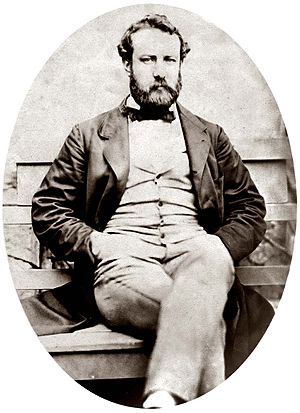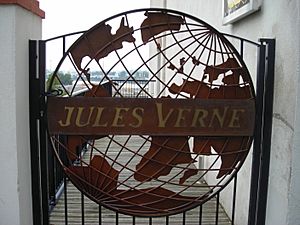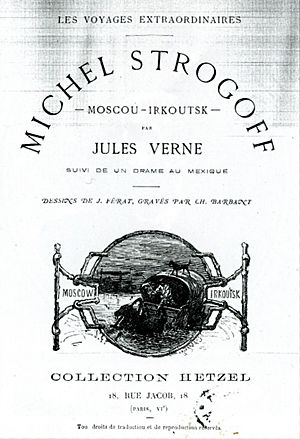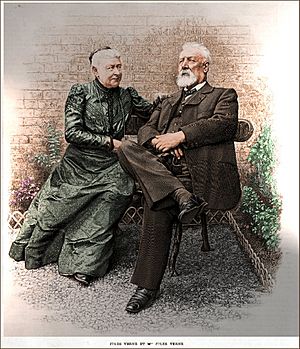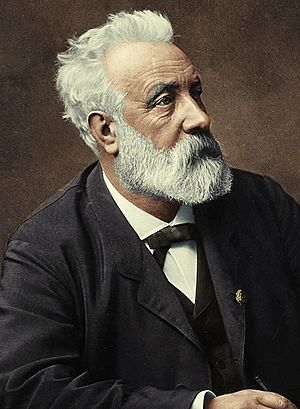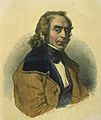Jules Verne facts for kids
Quick facts for kids
Jules Verne
|
|
|---|---|
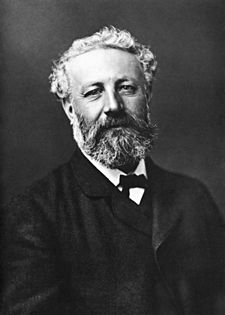
Photograph by Nadar c. 1878
|
|
| Born | Jules Gabriel Verne 8 February 1828 Nantes, France |
| Died | 24 March 1905 (aged 77) Amiens, France |
| Resting place | La Madeleine cemetery, Amiens, France |
| Occupation | Novelist, poet, playwright |
| Nationality | French |
| Period | 1850–1905 |
| Notable works |
|
| Spouse | Honorine Hebe du Fraysse de Viane (Morel) Verne |
| Children | Michel Verne, 2 step-daughters |
| Signature | |
 |
|
Jules Gabriel Verne (born February 8, 1828 – died March 24, 1905) was a French writer. He wrote novels, poems, and plays. Verne was born in Nantes, a seaport city in France. He was supposed to become a lawyer like his father. But he chose to write for magazines and the stage instead.
He worked with a publisher named Pierre-Jules Hetzel. Together, they created the Voyages extraordinaires (Extraordinary Journeys) series. These were popular adventure novels based on careful research. Some famous books from this series include Journey to the Center of the Earth (1864), Twenty Thousand Leagues Under the Sea (1870), and Around the World in Eighty Days (1873).
Many people in France and Europe see Verne as a very important writer. He influenced many modern writers and art movements. In English-speaking countries, he is often known for genre fiction or children's books.
Since 1979, Jules Verne has been the second most-translated author in the world. Only Agatha Christie and William Shakespeare are translated more often. Some people call him the "Father of Science Fiction." This title is also sometimes given to H. G. Wells and Hugo Gernsback.
Contents
Jules Verne's Early Life
Jules Gabriel Verne was born on Île Feydeau. This is a small island in the Loire River in Nantes. His father, Pierre Verne, was a lawyer. His mother, Sophie Allote de la Fuÿe, came from a family of sailors and shipowners. In 1829, his brother Paul was born, and later three sisters joined the family.
In 1834, when Jules was six, he went to boarding school. His teacher was a naval captain's widow. She often told stories about her husband being a shipwrecked sailor. She said he would return like Robinson Crusoe. This idea of being stranded on a desert island stayed with Verne. It appeared in many of his novels. These include The Mysterious Island (1874) and The School for Robinsons (1882).
In 1836, Verne went to a Catholic school called École Saint‑Stanislas. He was very good at remembering things, geography, Greek, Latin, and singing.
In 1840, his family moved to a larger apartment. Verne then went to another religious school. From 1844 to 1846, Jules and his brother studied at the Lycée Royal in Nantes. He finished his studies and passed his final exams in 1846.
By 1847, at age 19, Verne was serious about writing. He wrote long stories, inspired by Victor Hugo. However, his father expected him to become a lawyer. In 1847, Verne's father sent him to Paris to study law.
After a short time in Paris, Verne returned to Nantes. He met Rose Herminie Arnaud Grossetière and fell in love. He wrote about 30 poems for her. But her parents wanted her to marry a rich landowner instead.
Studying in Paris
In July 1848, Verne went back to Paris. His father wanted him to finish law school and become a lawyer. Verne shared an apartment with another student from Nantes. He used his family connections to meet people in Paris society. His uncle introduced him to literary salons, which were gatherings of writers and artists.
While studying law, Verne also followed his passion for theater. He wrote many plays. He worked hard at his law studies and earned his law degree in January 1851.
During this time, Verne wrote to his parents about his expenses and health. He suffered from stomach cramps and later, facial paralysis. These health issues were due to an ear problem, though he didn't know the cause at the time.
In 1851, Verne was supposed to join the French military. But he was lucky and didn't have to serve. He had strong anti-war feelings throughout his life.
Starting His Writing Career
In 1849, Verne met Alexandre Dumas, a famous writer. Verne became good friends with Dumas' son. He showed them a play he had written. The two young men worked on the play together. Dumas' father helped get it produced at a theater in Paris. It opened on June 12, 1850.
In 1851, Verne met Pierre-Michel-François Chevalier. He was the editor of a magazine called Musée des familles (The Family Museum). Chevalier was looking for articles about geography, history, science, and technology. He wanted to make these topics easy for many people to understand. Verne loved research, especially geography, so he was perfect for the job.
Verne first wrote a short historical adventure story called "The First Ships of the Mexican Navy". Chevalier published it in July 1851. That same year, he published another short story, "A Voyage in a Balloon".
Verne spent a lot of time at the Bibliothèque nationale de France (National Library of France). He researched for his stories and learned about science and new discoveries, especially in geography. There, he met Jacques Arago, a famous geographer and explorer. Arago was blind but still traveled a lot. They became good friends. Arago's interesting travel stories inspired Verne to write a new kind of travel literature.
Verne started working on an idea for a "Science Novel." It was inspired by his "love for maps and the great explorers of the world." This idea became his first published novel, Five Weeks in a Balloon, a story about traveling across Africa.
Family Life
In May 1856, Verne went to Amiens for a friend's wedding. He stayed with the bride's family and liked them very much. He was especially interested in the bride's sister, Honorine. To get a steady income and be closer to her, he decided to join her brother's business. Verne's father was unsure at first but agreed in November 1856. With his finances looking better, Verne won over Honorine and her family. They were married on January 10, 1857.
Verne focused on his new business. He woke up early every morning to write before work. He also kept doing scientific and historical research. He copied notes onto cards, a system he used for the rest of his life.
In July 1858, Verne got a chance to travel for free. He went on a sea voyage from Bordeaux to Liverpool and Scotland. This was his first trip outside France, and it made a big impression on him. When he returned to Paris, he used his memories in his stories. In 1861, he took another trip to Stockholm, Christiania, and through Telemark.
Verne rushed back to Paris from Denmark. He missed the birth of his only biological son, Michel, on August 3, 1861. Michel later married an actress, which his father didn't approve of. He also got into debt. However, their relationship improved as Michel grew older.
Later Years and Legacy
Jules Verne was raised Catholic. But in his later years, from about 1870, he became a deist. This means he believed in God but not necessarily in organized religion. Some people think this belief is shown in his novels. They often mention God or a divine plan but rarely mention Christ.
On March 9, 1886, something unfortunate happened. As Verne was coming home, his 26-year-old nephew, Gaston, shot him. The second bullet hit Verne's left leg, causing a permanent limp. This event was kept quiet in the news. Gaston spent the rest of his life in a mental asylum.
In 1888, Verne got involved in politics. He was elected as a town councilor in Amiens. He worked to improve the town for 15 years. He was honored with the Chevalier de la Légion d'honneur in 1870. He was promoted to an Officier de la Légion d'honneur in 1892.
Death and Lasting Impact
On March 24, 1905, Jules Verne died at his home in Amiens. He had been ill with diabetes. His son, Michel Verne, helped publish two of his father's novels after his death: Invasion of the Sea and The Lighthouse at the End of the World. The Voyages extraordinaires series continued for several years.
Later, it was found that Michel Verne had changed these stories a lot. The original versions were finally published much later, at the end of the 20th century. In 1919, Michel Verne published The Barsac Mission. The first drafts of this book showed his father's interest in Esperanto, an invented language. In 1989, Verne's great-grandson found a novel that had never been published. It was called Paris in the Twentieth Century, and it was published in 1994.
After Verne's death, many scholars and young writers in France became very interested in his works. They saw his novels as serious literature and noted his influence on their own writing. Some of them started the Société Jules Verne, the first group for studying Verne's works.
Verne's novels have had a big impact on both literature and science. He is known for helping to inspire the steampunk genre. This is a style of science fiction that uses 19th-century technology in a cool way.
Published in Verne's Lifetime
| Original French title | Most common English title | Year |
|---|---|---|
| Cinq Semaines en ballon | Five Weeks in a Balloon | 1863 |
| Voyages et aventures du capitaine Hatteras | The Adventures of Captain Hatteras | 1864 |
| Voyage au centre de la Terre | Journey to the Center of the Earth | 1864 |
| De la Terre à la Lune | From the Earth to the Moon | 1865 |
| Les Enfants du capitaine Grant | In Search of the Castaways | 1865 |
| Vingt Mille Lieues sous les mers | Twenty Thousand Leagues Under the Sea | 1869 |
| Autour de la Lune | Around the Moon | 1869 |
| Une Ville flottante | A Floating City | 1870 |
| Aventures de trois Russes et de trois Anglais | The Adventures of Three Englishmen and Three Russians in South Africa | 1871 |
| Le Pays des fourrures | The Fur Country | 1872 |
| Le Tour du monde en quatre-vingts jours | Around the World in Eighty Days | 1872 |
| L'Île mystérieuse | The Mysterious Island | 1874 |
| Le Chancellor | The Survivors of the Chancellor | 1874 |
| Michel Strogoff | Michael Strogoff | 1876 |
| Hector Servadac | Off on a Comet | 1877 |
| Les Indes noires | The Child of the Cavern | 1877 |
| Un Capitaine de quinze ans | Dick Sand, A Captain at Fifteen | 1878 |
| Les Cinq Cents Millions de la Bégum | The Begum's Fortune | 1879 |
| Les Tribulations d'un Chinois en Chine | Tribulations of a Chinaman in China | 1879 |
| La Maison à vapeur | The Steam House | 1879 |
| La Jangada | Eight Hundred Leagues on the Amazon | 1881 |
| L'École des Robinsons | Godfrey Morgan | 1882 |
| Le Rayon vert | The Green Ray | 1882 |
| Kéraban-le-têtu | Kéraban the Inflexible | 1883 |
| L'Étoile du sud | The Vanished Diamond | 1884 |
| L'Archipel en feu | The Archipelago on Fire | 1884 |
| Mathias Sandorf | Mathias Sandorf | 1885 |
| Un Billet de loterie | The Lottery Ticket | 1886 |
| Robur-le-Conquérant | Robur the Conqueror | 1886 |
| Nord contre Sud | North Against South | 1887 |
| Le Chemin de France | The Flight to France | 1887 |
| Deux Ans de vacances | Two Years' Vacation | 1888 |
| Famille-sans-nom | Family Without a Name | 1889 |
| Sans dessus dessous | The Purchase of the North Pole | 1889 |
| César Cascabel | César Cascabel | 1890 |
| Mistress Branican | Mistress Branican | 1891 |
| Le Château des Carpathes | Carpathian Castle | 1892 |
| Claudius Bombarnac | Claudius Bombarnac | 1892 |
| P'tit-Bonhomme | Foundling Mick | 1893 |
| Mirifiques Aventures de Maître Antifer | Captain Antifer | 1894 |
| L'Île à hélice | Propeller Island | 1895 |
| Face au drapeau | Facing the Flag | 1896 |
| Clovis Dardentor | Clovis Dardentor | 1896 |
| Le Sphinx des glaces | An Antarctic Mystery | 1897 |
| Le Superbe Orénoque | The Mighty Orinoco | 1898 |
| Le Testament d'un excentrique | The Will of an Eccentric | 1899 |
| Seconde Patrie | The Castaways of the Flag | 1900 |
| Le Village aérien | The Village in the Treetops | 1901 |
| Les Histoires de Jean-Marie Cabidoulin | The Sea Serpent | 1901 |
| Les Frères Kip | The Kip Brothers | 1902 |
| Bourses de voyage | Travel Scholarships | 1903 |
| Un Drame en Livonie | A Drama in Livonia | 1904 |
| Maître du monde | Master of the World | 1904 |
| L'Invasion de la mer | Invasion of the Sea | 1905 |
Images for kids
-
Twenty Thousand Leagues Under the Sea: In 1866, ships from different countries see a strange sea monster. Some think it's a giant narwhal. The U.S. government sends an expedition from New York City to find and destroy it.
-
An early edition of the Griffith & Farran adaptation of Journey to the Center of the Earth.
-
A monument to Jules Verne in Redondela, Spain.
See also
 In Spanish: Julio Verne para niños
In Spanish: Julio Verne para niños


